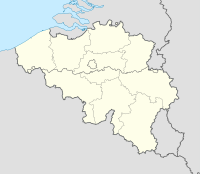| Battle of Hannut | |||||
|---|---|---|---|---|---|
| Part of the Battle of Belgium in World War II | |||||
| |||||
| Belligerents | |||||
|
|
| ||||
| Commanders and leaders | |||||
|
|
| ||||
| Strength | |||||
|
2 armoured divisions 20,800 personnel 600 AFVs[2][Notes 2] |
2 Panzer divisions 25,927 personnel 618 tanks (some sources say 674)[3] 108 artillery pieces [2][Notes 3] 1,252 aircraft | ||||
| Casualties and losses | |||||
| 121 tanks destroyed/damaged or abandoned[4] |
52 tanks destroyed 111 tanks damaged [5] | ||||
The Battle of Hannut was a Second World War battle fought during the Battle of Belgium which took place between 12 and 14 May 1940 at Hannut in Belgium. It was the largest tank battle in the campaign. It was also the largest clash of tanks in armoured warfare history at the time.
The primary purpose of the Germans was to tie down the strongest elements of the French First Army and keep it away from the main German attack by Army Group A through the Ardennes, as laid down in the German operational plan Fall Gelb (Case Yellow), by General Erich von Manstein. The German breakout of the Ardennes was scheduled for 15 May, five days after the German attacks on the Netherlands and Belgium. The delay was to entice the Allies into believing the main thrust would, like the Schlieffen Plan in World War I, come through Belgium and then down into France. When the Allied armies advanced into Belgium according to the Dyle Plan, they would be tied down by German offensive operations in eastern Belgium at Hannut and Gembloux. With the flank of the First Army exposed, the Germans could thrust to the English Channel which would encircle and destroy the Allied forces. For the French, the plan in Belgium was to prepare for a prolonged defence at Gembloux, about 34 km (21 mi) west of Hannut. The French sent two armoured divisions forward, to conduct a delaying action against the German advance and give the rest of the First Army time to dig in at Gembloux.
The Germans reached the Hannut area just two days after the start of the invasion of Belgium but the French defeated several German attacks and fell back on Gembloux as planned. The Germans succeeded in tying down substantial Allied forces, which might have participated in the Battle of Sedan, the attack through the Ardennes. The Germans failed to neutralise the French First Army completely at Hannut, despite inflicting significant casualties. The French forces successfully delayed the German advance while allowing the First Army to situate itself at Gembloux, where, a couple of days later, the German advance lost over a third of its armor in combat.
The French once again scored tactical successes at the Battle of Gembloux from 14–15 May. In the aftermath of that battle, although seriously damaged, the First Army was able to retreat to Lille, where it delayed the Germans in the Siege of Lille and was instrumental in the re-embarkation of the British Expeditionary Force, French and Belgian troops at the Evacuation of Dunkirk.
- ^ Gunsburg 1992, p. 216
- ^ a b Gunsburg 1992, p. 210
- ^ Battistelli & Anderson 2007, p. 75
- ^ Gunsburg 1992, p. 236
- ^ Gunsburg 1992, p. 237
Cite error: There are <ref group=Notes> tags on this page, but the references will not show without a {{reflist|group=Notes}} template (see the help page).
